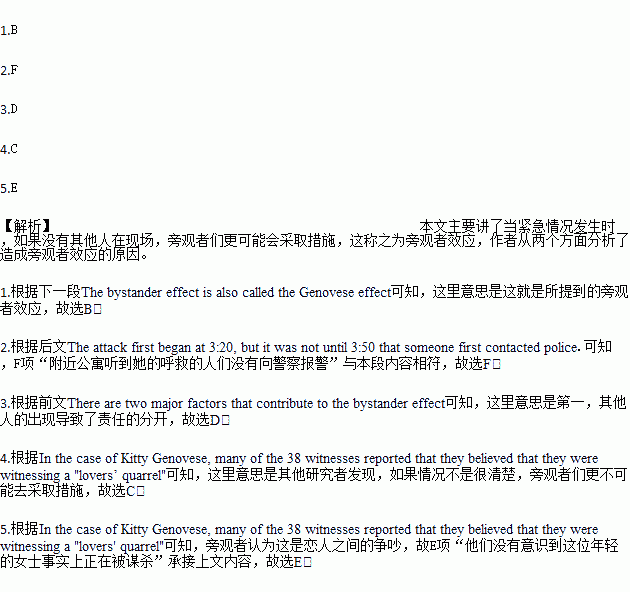题目内容
The Bystander (旁观者) Effect
When an emergency situation occurs, observers are more likely to take action if there are few or no other witnesses. 1.
The bystander effect is also called the Genovese effect, which is named after Catherine “Kitty” Genovese, a young woman who was cruelly murdered on March 13, 1964. Early in the morning, 28-year-old Genovese was returning home from work. As she approached her apartment entrance, she was attacked and stabbed (刺) by a man later identified as Winston Moseley. Despite Genovese's repeated cries for help, 2. The attack first began at 3:20, but it was not until 3:50 that someone first contacted police.
Many psychologists were set thinking by the incident, as well as most Americans. As the conclusion, the bystander effect came out and later proved by a series of studies and experiments.
There are two major factors that contribute to the bystander effect. 3. Because there are other observers, individuals do not feel as much pressure to take action, since the responsibility to take action is thought to be shared among all of those present. The second reason is the need to behave in correct and socially acceptable ways. When other observers fail to react, individuals often take this as a signal that a response is not needed or not appropriate.
4. In the case of Kitty Genovese, many of the 38 witnesses reported that they believed that they were witnessing a "lovers' quarrel", and 5..
A. They hesitate and assess the risk of getting hurt
B. This phenomenon is referred to as the bystander effect.
C. Other researchers have found that onlookers are less likely to take action if the situation is unclear.
D. First, the presence of other people creates a division of responsibility.
E. they did not realize that the young woman was actually being murdered.
F. none of the people in the nearby apartment building who heard her cries called police for help.
G. the attacker didn’t stop stabbing her.


 ous and 2.(disappoint).When the bus finally came,we all hurried on board.I got a place next 3. the window,so I had a good view of the sidewalk.A boy on a bike caught my attention.He 4.(ride) beside the bus and waving his arms.I heard a passenger behind me shouting to the driver, 5. he refused to stop 6. we reached the next stop.Still,the boy kept riding.He was carrying something over his shoulder and shouting.Finally,when we ca
ous and 2.(disappoint).When the bus finally came,we all hurried on board.I got a place next 3. the window,so I had a good view of the sidewalk.A boy on a bike caught my attention.He 4.(ride) beside the bus and waving his arms.I heard a passenger behind me shouting to the driver, 5. he refused to stop 6. we reached the next stop.Still,the boy kept riding.He was carrying something over his shoulder and shouting.Finally,when we ca me to the next stop,the boy came up to the door of the bus,and I heard an 7. (excite)conversation.Then the driver stood up and asked,“Did anyone lose a suitcase at the last stop?” A woman on the bus shouted,“Oh dear! It's 8. (I).”She pushed her way to the driver and took the suitcase thankfully.Everyone on the bus began talking about what the boy 9. (do),and the crowd of strangers 10. (sudden)became friendly to one another.
me to the next stop,the boy came up to the door of the bus,and I heard an 7. (excite)conversation.Then the driver stood up and asked,“Did anyone lose a suitcase at the last stop?” A woman on the bus shouted,“Oh dear! It's 8. (I).”She pushed her way to the driver and took the suitcase thankfully.Everyone on the bus began talking about what the boy 9. (do),and the crowd of strangers 10. (sudden)became friendly to one another.